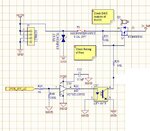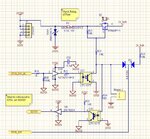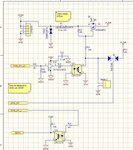oahmad
Newbie level 5

Hi Guys,
Attached is my circuit.

The way it is intended to work is as follows:
The Mosfet is supposed to be off via the pullup R21=10K
When the PWR_SW_uC line is High, it is supposed to turn on the diode on the optoisoaltor turning on the optoisolator transistor which pulls down R33=14K. Due to the divider from 24VDC and R21 and R33, the Gate of the PMOS Q2 is pulled to 14V which turns on the PMOS. The divider is there to prevent the gate from going lower than the source to less than 16V (according to the datasheet).
So it turns on OK. I am having trouble keeping the PMOS off. The gate of the PMOS is around 18VDC. I disconnected the Optoisolator by lifting the Collector to make sure it wasn't the culprit and have ruled it out. Basically the pullup is not working as-is. I tried a lower value pullup (Changed R21 to 1K and R33 to 1.4K), and brought the gate to around 20VDC...not fully off still.
Can someone please help?
Thanks!
Attached is my circuit.

The way it is intended to work is as follows:
The Mosfet is supposed to be off via the pullup R21=10K
When the PWR_SW_uC line is High, it is supposed to turn on the diode on the optoisoaltor turning on the optoisolator transistor which pulls down R33=14K. Due to the divider from 24VDC and R21 and R33, the Gate of the PMOS Q2 is pulled to 14V which turns on the PMOS. The divider is there to prevent the gate from going lower than the source to less than 16V (according to the datasheet).
So it turns on OK. I am having trouble keeping the PMOS off. The gate of the PMOS is around 18VDC. I disconnected the Optoisolator by lifting the Collector to make sure it wasn't the culprit and have ruled it out. Basically the pullup is not working as-is. I tried a lower value pullup (Changed R21 to 1K and R33 to 1.4K), and brought the gate to around 20VDC...not fully off still.
Can someone please help?
Thanks!


